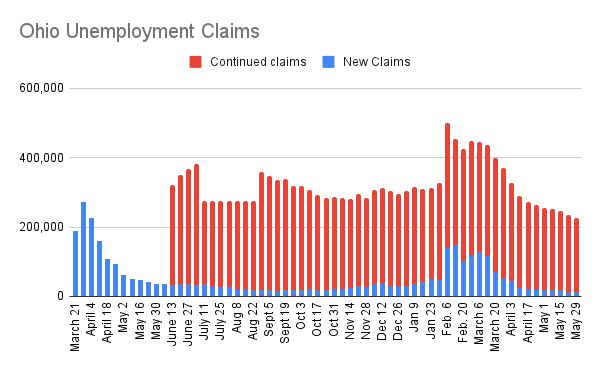New Unemployment Claims in Ohio Rise Slightly
COLUMBUS, Ohio – The number of new unemployment claims filed in Ohio were rose slightly last week as the Department of Job and Family Services reports 13,995 claims were submitted.
That number is up about 300 – a 2.4% increase – from the total for the week ended May 22, when Ohio saw its lowest number of new claims since the start of the pandemic – 13,661.
There were also 211,991 continued claims filed with the state the week ended May 29, down nearly 9,000 from the previous week and a new low since the state began reporting such claims in mid-June.
Over the past 63 weeks, the state has disbursed $11.7 billion in traditional unemployment compensation to more than 1 million people, as well as $10.3 billion in pandemic unemployment assistance to 1.1 million who aren’t eligible for traditional benefits, such as workers in part-time jobs and the self-employed.

In Pennsylvania, the state’s Department of Labor reports 24,253 new claims filed the week ended May 22, up just over 1,000 from the previous week. So far in 2021, there have been 508,439 initial claims submitted.
Through May 29, the state has paid $44.1 billion in unemployment compensation, including $7.8 billion in traditional unemployment and $9.4 billion in pandemic unemployment assistance.
Nationwide, the number of people seeking unemployment dropped to 385,000, marking the fifth straight week of declines and a new pandemic low.
The number of weekly applications for unemployment aid, which generally reflects the pace of layoffs, has fallen steadily all year, though it remains high by historical standards.
The decline in applications reflects a swift rebound in economic growth and the job market’s steady recovery from the coronavirus recession. More Americans are venturing out to shop, travel, dine out and congregate at entertainment venues. All that renewed spending has led companies to seek new workers.
Employers have added 1.8 million jobs this year — an average of more than 450,000 a month — and the government’s May jobs report on Friday is expected to show that they added an additional 656,000 last month, according to a survey of economists by the data firm FactSet. The economy remains down 8.2 million jobs from its level in February 2020, just before the virus tore through the economy.
Yet U.S. employers are posting a record number of available jobs. And many of them have complained that they can’t find enough workers to meet rising customer demand.
Job growth slowed sharply in April compared compared with March, a pullback that was widely attributed to a labor shortage in some industries, especially at restaurants and other employers in the hospitality sector.
At least 25 states have responded by announcing plans to cut off some emergency federal aid to the unemployed — including a $300-a-week federal benefit — as early as next week. Critics argue that the extra federal unemployment aid, on top of regular state jobless benefits, discourages some of the jobless from seeking work.
Weekly applications for unemployment aid, which topped 900,000 in early January, have fallen steadily all year, though they remain high by historical standards: Before COVID-19 all but paralyzed the economy in March 2020, claims were regularly coming in below 230,000 a week.
In the week that ended May 15, a total of 15.4 million people were receiving some form of jobless aid, including special federal programs to aid the unemployed during the pandemic. That was down from 15.8 million the previous week. That figure has steadily declined from about 20 million in December.
The Associated Press contributed to this story.
Copyright 2024 The Business Journal, Youngstown, Ohio.



